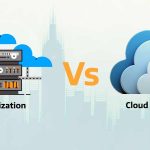A private cloud is a software-defined data center that combines essential hardware and other computing resources into a unified virtualized unit A private cloud’s layer of hardware and networking abstraction – again, provided by software – enables enterprises to scale and provision resources more dynamically than is possible with traditional hardware-centric computing environments.
In contrast to public cloud computing, a private cloud is typically hosted within a company’s firewalls. Alternately, some companies host their private cloud with an external third party provider, which allows these deployments to tap into external compute resources on an on-demand basis.
What is Private Cloud?
Private cloud is preferred by many companies because it offers a degree of privacy and compliance that may be less challenging – or at least less complicated – than a public cloud. Additionally, a private cloud infrastructure is closer to that of a legacy data center, so plenty of companies see it as an easier transition to cloud computing. Yet despite those advantages, a certain amount of confusion remains about private cloud, its technology and its larger implications for enterprise IT. Here we take an expert look at private cloud:
Private Cloud Challenges
Despite its significant promise, a private cloud faces challenges. As with traditional deployments, companies must still handle (or pay for) the majority of achitecting and monitoring work themselves. And because private cloud is still emerging technology, a deployment built this year will likely soon call for a revision of some type. For this reason (among others) businesses of varying sizes are opting for hybrid clouds – a term that comprises any number of permutations of private and public clouds.
To be sure, the world of private cloud computing suffers from a phenomenon that few vendors will admit: confusion. Sure, the term private cloud can be defined, yet vendors and pundits tend to disagree on the specifics. For a time, merely using virtualization in your data center meant you had a private cloud; other experts point out that this is only the foundation.
This confusion comes to the fore when businesses go shopping for a private cloud solution. Do you want a full-fledged third party infrastructure as a service solution, or do you simply want to virtualize, say, your southwestern offices? Issues like tiered staff access, control of databases, scheduled provisioning, and application management can quickly spiral into a labyrinthine (and costly) array of choices.
So when planning and building a private cloud – either completely in-house or with any level of vendor involvement – businesses must keep their own goals squarely in place. Why, exactly, are you constructing a new private cloud; what do you want it to do? Looking past the blizzard of choices, the answer to this question is best placed at the very top of your private cloud architecture plan.

As cloud computing proliferates, private clouds are typically part of a hybrid cloud deployment. (Source: Appistry)
In-House or Third Party Private Cloud?
Before building a private cloud, a business must decide: do we want to run it in our own data center, or host it in a third party location?
· External private cloud: An externally hosted private cloud is often referred to as a managed private cloud. The concept of an external private cloud causes anxiety among businesses – for good reason. The core rationale a private cloud is so prized is because it offers greater security, privacy and control than a public cloud. So locating a private cloud in an external facility seems to negate this. Among the worries: The issue of data ownership. If, for instance, your private cloud host changes its end users agreements in some onerous way, how easy will it be for you to shift to a new provider?
- Security concerns: Also worrying is the possibility of a breach in security. While cloud service providers are better positioned to keep up with evolving security trends due to economies of scale, what happens when something goes wrong? Will the service provider accept accountability? Will they make you whole after, say, a data breach, or will you be left to clean up the mess and shoulder the costs?
- Reasons for external: Why then host your private cloud externally? Industry opinions differ wildly, but some pundits say that a business must have at least 1,000 servers to justify building its own private cloud. Many businesses don’t have near that amount. Hence the interest in hosting a private cloud with a third party provider, or in some way leveraging a managed private cloud from an external vendor.
- Hosted private cloud: In truth, a hosted private cloud – the managed private cloud – is far different than a public cloud from a big public cloud vendor like, say, Amazon. In a managed private cloud scenario, a business extends a separate security perimeter around this third party cloud.
In effect, your business simply cordons off a section of the third party’s equipment and infrastructure. This saves your business the cash outlay of building/buying this extra equipment and infrastructure, yet also provides (in theory, at least) the same level of privacy and security as would a truly in-house deployment. Many managed clouds enable you to boost your security, allowing you to move specific apps (say, those applicable to mobile workers) into the private cloud; and you can often consume “security as a service,” such as BYOD (bring your own device) security and DLP (data loss prevention) services.
Naturally, your business must select a managed private cloud provider that includes the necessary regulatory compliance security practices to meet rigorous industry standards.

A private cloud comprises a unified, integrated software-defined data center – whether in a company’s in-house data center or in an external facility.
Customized vs. Commodity Build
Cost is of course a central concern as you create plans for a private cloud deployment.
- Cost per VM: A key metric to bear in mind when a business decides to deploy a private cloud is cost per VM (virtual machine) per month. This cost can vary exponentially based on a dizzying menu of factors. Erik Sebesta, Chief Architect and Technology Officer at Cloud Technology Partners, a Boston-based consulting firm, has advised many businesses as they’ve set up private cloud deployments.
- Estimating costs: Sebesta indicates the following cost levels. For in-house datacenters that aren’t running a private cloud, the cost per VM per month can be substantial. This amount can fall substantially if a business uses a managed private cloud – (but again, many factors are in play here).
- Typical costs: “If you build your own equivalent to Amazon – and there are companies out there that do this – you can reduce the cost per VM per month,” he says. While some businesses might be leery of the upfront expense of building it themselves, Sebesta says that, “You can find pre-configured packages that are ready to run with limited custom work.”a Although there are extra professional costs in getting this installed, the longer term operating costs can fall significantly. Still, he adds a note of caution: “Going into a buying decision without an understanding of where the various price points are, it’s easy to get led astray by the big vendors with their Cloud-in-a-Box offerings.” (See more on Cloud-in-a-Box in the section below.)
- Comparing vendors: To fully understand the price variables, a private cloud customer needs to compare some of the leading-edge private cloud vendors. To cut costs, Sebesta says, look for vendors who are using open source solutions and commodity hardware.



Comments are closed